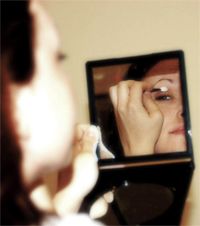Shea butter can be used as a hair conditioner or to fight dandruff. It can be used as a daily moisturizer, and it can be used to soothe burns and minimize scarring. It's even edible -- it's often used in chocolate as a substitute for cocoa butter [source: Karité]. Shea -- whether called a butter or lotion -- is often touted as a miracle ingredient in cosmetics and lotions. Its use in cosmetics worldwide is relatively new, but shea butter has been widely used in parts of Africa for centuries -- for moisturizing, healing and cooking [source: Cherry].
Shea butter comes from a tree that's indigenous to sub-Saharan West Africa. It's an excellent emollient and anti-inflammatory that's rich in fatty acids and vitamins A, E and K [source: Elias]. These vitamins and nutrients are essential to healthy skin because they do the following:
Advertisement
- Vitamin A: Studies show that vitamin A reduces lines and wrinkles, controls acne and provides some psoriasis relief.
- Vitamin E: Applying vitamin E to skin helps repair sun damage, reduce wrinkles and improve skin texture.
- Vitamin K: Topical vitamin K reduces bruises, spider veins and wrinkles.
- Fatty acids: If your skin is dry, inflamed or prone to whiteheads and blackheads, your skin may lack essential fatty acids. Without an adequate supply of these nutrients, skin can produce a more irritating form of sebum, or oil, that can cause acne and skin irritation [source: Bouchez].
Shea butter creation is a process that's been passed down from one generation of African women to the next. Read on to learn more about this demanding work.
Advertisement

